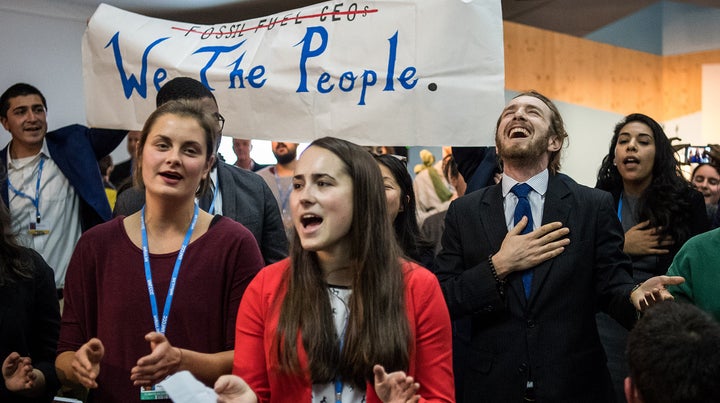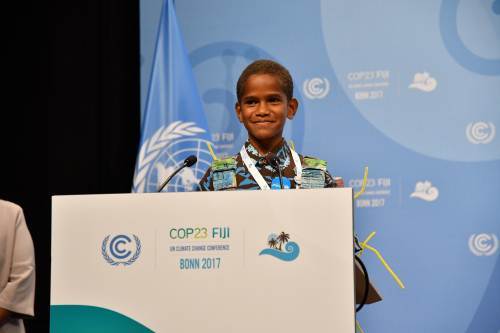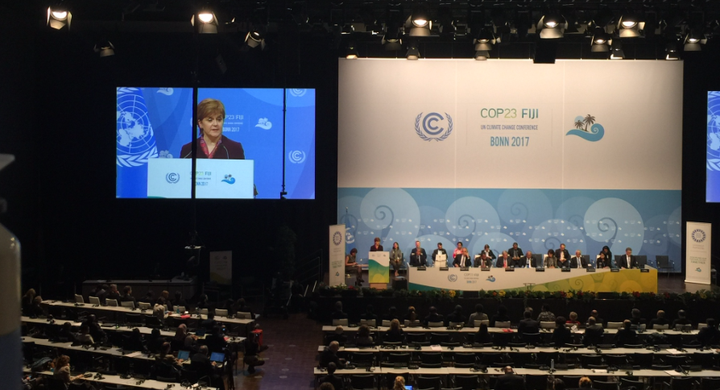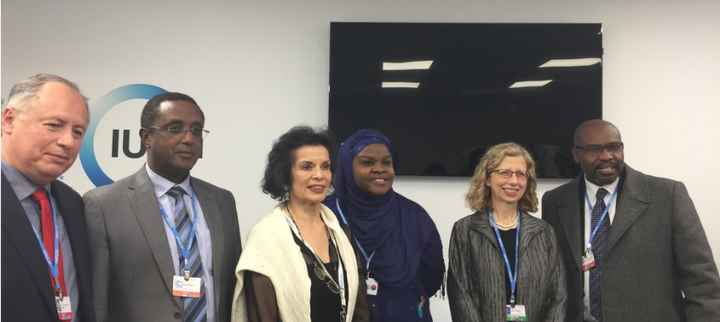
‘And we proudly stand up, Until you keep it in the ground....’
Young protesters disrupting White House panel at COP23
I have been at COP23 for the past two weeks. Twenty thousand people ― world leaders, delegates, NGOs, indigenous groups from countries from around the world ― descended on the small sleepy town of Bonn, Germany to negotiate the details of implementation for the Paris Agreement. Corporations and lobbies came to push their toxic fossil fuel agendas.
Climate change is the biggest threat we face in our time. For two consecutive years we have broken the record for the highest annual global temperature ever recorded. We are already experiencing the consequences of a warming world: Sea levels are rising, glaciers are melting and precipitation patterns are changing, natural disasters and extreme weather events are becoming more intense and more frequent; species are being lost for ever in every ecosystem; increasing desertification, food and water scarcity and political unrest. The future of the planet is at stake. Yet world leaders seem unable to commit to measures which will limit climate change, and ensure a world for future generations.
With less than 24 hours of negotiations left, who is putting a spoke in the wheel? Who is the villain of the piece? There are plenty of candidates for the role.
White House Protests
On November 13th, I fought my way through crowds into the U.S. press briefing inside the Bonn Zone at the conference. Security cordoned off the area, preventing people from entering the corridor where the briefing was held. The panel, sponsored by the White House, had been entitled ”Action on Spurring Innovation and Deploying Advanced Technologies.” Weeks before, the U.S. changed the name of the event to “The Role of Cleaner and More Efficient Fossil Fuels and Nuclear Power in Climate Mitigation.” It was an ominous sign of things to come. I wondered if this was some kind of sick joke.
This was the only event the U.S. planned at COP23 and it quickly became evident why. As George David Banks, Trump’s special assistant for international energy and environment, gave introductory remarks and Francis Brooke, an aide to Vice President Mike Pence, moderated, the event was revealed for what it was: a shameful promotion of coal, nuclear and gas. It was, as Michael Bloomberg put it later, like “bringing tobacco to cancer a summit.” I was aghast. We were all in a state of disbelief.
Suddenly, about a third of those in the room got to their feet. They were young college-age people. They brought out a banner, reading “We the People,” raised it high and began to sing to the tune of “God Bless the U.S.A”:
So you claim to be an American
But we see right through your greed
It’s killing all across the world
For that coal money.
And we proudly stand up
Until you keep it in the ground.
We the people of the world unite
And we are here to stay.
They all turned around, symbolically showing their backs to the panel. I was very moved by their defiance. They wanted the Trump administration and its minions seated on the platform to understand that fossil fuels and nuclear power are a threat to our survival and the environment. They weren’t going to take it lying down, they were “here to stay.” I was glad that security were either too slow or unwilling to force them out of the room, as usually happens to protesters. They left, singing their song, shouting that anyone who chose could follow them to ‘the people’s summit.’
After their courageous intervention, the mood in the room changed. For some of the audience, disbelief now gave way to anger. People were muttering under their breath. There were boos and hisses. The audience questions were challenging, some openly hostile.
Climate Home News asked if the Trump administration held to the policy that the 2-degree Celsius, or 3.6-degree Fahrenheit warming target from the Paris deal must be avoided at all costs. George David Banks replied: “I actually don’t know that means.”
Throughout the questions, a voice at the back of the room called at intervals - “You are all f―-ing liars!”
Finally, Amy Goodman of Democracy Now asked the panel whether they supported Trump’s withdrawal from the Paris Agreement. Most were evasive. When Lenka Kollar, director of business strategy for NuScale Power, said she did not support the decision, the crowd cheered. I did not join in. It felt like an empty victory.
There is no doubt that the fossil fuel lobby has a strong foothold at the negotiations. “Bribery is exactly what is going on,” former NASA scientist James Hansen, told the Guardian on the sidelines of the talks in Bonn. For decades Hansen has been one of the leading voices warning us of the threat of climate change. He called today for the 100 big “carbon majors” ― corporations like ExxonMobil, BP and Shell that are, by one account, responsible for more than 70 percent of emissions ― to pay for the transition to cleaner energy and greater forests through litigation. Until governments make them do so by introducing carbon fees or taxes, he says, the best way to hold them to account and generate funds is to sue them for the damage they are doing to the climate, those affected and future generations. Once again, he is right.
Fiji
The young people’s intervention at the White House panel was not the only inspiring moment at COP23. This year the COP is hosted by Fiji (though held in Germany for practical reasons) For the first time, a small island whose future is profoundly affected by climate change has the Presidency of the COP. The fatal consequences of a warming world are front and centre, at COP23.
Twelve-year old Timoci Naulusala, whose village in Fiji’s Tailevu province was hit by Cyclone Winston last year addressed the COP on Wednesday, November 15th, at the opening of the high-level segment. He had won a competition among all primary school children in Fiji to deliver his message to the COP.
“My home, my school, my source of food, water, money was totally destroyed,’ he said. ’ My life was in chaos. The sea is swallowing villages, eating away at shorelines, withering crops. Relocation of people...cries over lost loved ones, dying of hunger and thirst. Its catastrophic. It’s sad…but its real. You may think it will only affect small nations...you are wrong.”

Timoci Naulusala of Naivicula village in Wainibuka, Tailevu opened the high level segment of COP23, November 15th
COP23 has been so far a low-key conference. Outside of the young people’s intervention at the White House panel, there have not been many dramatic events. No great breakthroughs are expected in the negotiations. It is cold and has rained most of the time. Travel between the distant ‘Bula’ and ‘Bonn’ zones of the conference is damp and time-consuming. There is little of the sense of frantic urgency I felt two years ago at COP21 in Paris.
Inside the conference, there is plenty of water, and the information office offered free reusable water bottles, which were a godsend. The food is good with more options for vegetarians, which has been lacking at previous COPs. But access to Bonn Zone is very difficult, especially if you have a disability, with a long wet walk down a slippery hill. Getting to and from the Bonn Zone was a daily exercise in futility, waiting in the cold and the rain for taxis that did not show up. Access for wheelchairs was poor. The conference staff were helpful.
The logo for the conference is a dreamy image of two palm trees, and a stylised image of a wave.

The motto for the conference is “Further, Faster, Together for Climate Action.” Both logo and motto are plastered all over the walls of the shaky, cold prefabricated tents they have erected for the conference. So far I fear it is wishful thinking. My experience of Bonn has mirrored that of the negotiations. Things move slowly here, and with difficulty.
But we shouldn’t be surprised by the lack of concrete action. It has been a common trait of all the twenty three COPs. The stakes at COP23 are higher than ever; time is running out.
Inadequate Targets
Secretary General of the UN Antonio Guterres stated at the opening of the High Level Segment, “The world is not yet on track to meet the central goal of the 2015 Paris Agreement – to limit the global average temperature rise to well below two degrees Celsius and as close as possible to 1.5 degrees.”
In fact, the latest 2016 UNEP Climate Emissions Gap report, states that with the Paris pledges the world is heading for a temperature rise of 2.9 to 3.4 degrees this century. ‘2030 emissions will be 12 to 14 gigatonnes above levels needed to limit global warming to 2oC. The world must urgently and dramatically increase its ambition to cut roughly a further quarter off predicted 2030 global greenhouse emissions to have any chance of minimizing dangerous climate change,’ the report states. Another report using new climate modelling published in ’Nature’ magazine agrees - we must achieve zero net greenhouse gases emissions “well before 2040” - not 2050, or even worse 2100 as some are saying.
The Paris Agreement is the result of twenty years of international negotiation. If the U.S. withdraws as Donald Trump has announced, it will be the only country in the world not in the agreement. There is no doubt that the Agreement is an unprecedented diplomatic global achievement. But it is not enough. The current emissions cuts are heading us to at least a 3 degrees temperature rise - this will mean severe damage, according to UNEP. “If we don’t start taking additional action now, we will grieve over the avoidable human tragedy, says Erik Solheim, chief of UNEP.
Over 15,000 scientists from around the world came together on November 15th to sign and support an unprecedented “warning to humanity.” The letter marks the 25th anniversary since a similar letter was issued in 1992 by 1,700 scientists. The letter examines our progress in tackling climate change and the devastating damage it will cause to human life and the environment. It is not comforting reading. “Soon it will be too late to shift course away from our failing trajectory, and time is running out,” the letter warns. “We must recognize, in our day-to-day lives and in our governing institutions, that Earth with all its life is our only home.”
According to NASA human activity dumps 40 billion tonnes of Co2 into the atmosphere annually. Atmospheric carbon levels have risen 42% since the industrial revolution and are still rising achieving the highest rate on record in 2015 and 2016. The rate of increase has continued into 2017. Natural carbon sinks - our oceans, forests and the earth - are unable to keep up. We are literally scorching ourselves to death.
The future of the planet is hanging by a thread. If world leaders continue to refuse to heed the science, if they fail to significantly increase their ambition in reducing emissions and tackling climate change, the consequences will be dire, and irreversible.
NEGOTIATIONS
Loss and damage
The Paris Agreement includes a mechanism for the pledges to be reviewed and ratcheted up but how remains in question. The UN process remains tortuously slow and there is still much detail to be hammered out. Financial negotiations have been stalled this week by well-rehearsed arguments regarding financial mechanisms to compensate climate-vulnerable countries for so-called ‘loss and damage.’ Developed countries were deflecting discussions on creating a fund that will be used to address the adverse effects of climate change suffered by developing countries. Compromise was reached but transparency and fairness remain the perennial key issues, as at any COP.
Financing
The departure of the US has left a hole in the 10.2 billion dollars per year Green Climate Fund. President Macron said boldly in his opening statement, “I propose that Europe replaces America... and France will meet that challenge.” Countries, states and coalitions have rallied to fill the financial gap left by Trump’s withdrawal. This is encouraging. But the Fund has been referred to as ‘a laughing stock’ by poor countries as recently as April. Donor countries want to focus on large-scale infrastructure projects, instead of building climate-resilience within communities where it will benefit the worlds poorest and most vulnerable.
Accounting and the rule book
Here in Bonn world leaders must not only work out how to fulfil their pledges - they must step up their ambitions. To do this, they must ’develop a plan to monitor and verify the pledges made by nearly 200 countries to reduce greenhouse gas emissions.
Countries are seeking to agree on terms according to Deustche Welle, for the much-contested ‘rule-book.’
This will standardize reporting and oversight practises to quantify how much coal, oil and gas they use, and a standard formula to calculate greenhouse gas emissions as well as equations on farming and forestry practices to account for greenhouse gases from livestock, fertilizer use and changes in tree cover. These are the building blocks of the Paris Agreement - it will collapse without them.
The rule-book needs to be agreed on by COP24 next year, in Katowice, Poland according to the Paris Agreement’s timeline.
The foundation for the future must be laid in Bonn. If trust and communication break down agreements fall through and parties go home empty handed. We will risk a repeat of the despair and anger that followed the now-infamous, disastrous COP15 in Copenhagen, Denmark.
The success of any agreements reached will depend on involving all stakeholders - including women and indigenous people, who should be at the centre of the negotiations.
INDIGENOUS PEOPLE

Reverend Fletcher Harper, Executive Director of GreenFaith, Hindou Oumarou Ibrahim, Co-Chair, International Indigenous Peoples’ Forum, Bianca Jagger, President of the Bianca Jagger Human Rights Foundation, Sônia Guajajara, National Coordinator, Articulation of Indigenous Peoples of Brazil Benki Piyãko, Spiritual and political leader, Ashaninka community of the Amônia River,
Indigenous people’s wisdom should be the cornerstone of any climate negotiations.
Last Sunday, Forest Day at COP23, I had the honour of moderating a panel on ‘Leadership from Indigenous People and the World’s Religions,’ with Benki Piyãko, Spiritual and political leader, Ashaninka community of the Amônia River, Brazil, Reverend Fletcher Harper, Executive Director of GreenFaith, Sônia Guajajara, National Coordinator, Articulation of Indigenous Peoples of Brazil, and Hindou Oumarou Ibrahim, Co-Chair, International Indigenous Peoples’ Forum on Climate Change. They made some powerful statements regarding the exclusion of indigneous people from negotiations. To date indigenous people don’t have a seat at the negotiating tables at the UN Climate Change Conference. Although governments and international organisations have begun to take notice, most cannot even gain entrance to the high-level ‘Bula Zone.’ Their voices are not being heard. The panel called on world leaders and the UNFCCC to include indigenous people in negotiations and give them a seat at the table. I joined them in their call.
As Sônia said, ‘if you are serious about protecting nature you need to speak to the people who are already doing the job.’ I couldn’t agree more. We need to hear from women and indigenous people, who both play a critical role in combating climate change.
The ILO released a report in April titled ‘Indigenous Peoples and Climate Change: From Victims to Change Agents through Decent Work.’ The title itself is telling. Perceptions are changing. Indigenous people who have previously been considered ‘victims’ are now being recognised as a powerful force in addressing climate change. The ILO calls for indigenous peoples to “be seen as powerful agents of change,” and accorded access to decent work opportunities and the ability to participate in the development of climate change measures.’
Indigenous people have long been proven to be the best custodians of biodiversity in their ancestral lands. They use the forests and natural resources sustainably. They are among the most vulnerable groups in terms of climate change - but they are a critical part of the solution.
Around 70 million indigenous peoples are dependent on forests to meet their livelihood needs. Indigenous people account for 5 per cent of the world’s population, but care for and protect 22 per cent of the Earth’s surface and 80 per cent of the planet’s biodiversity.
In Latin America and Asia alone, indigenous peoples and local communities manage about one third of all tropical forests. And the climate benefits from indigenous peoples’ action are high. The indigenous managed forests in just four tropical regions--the Amazon Basin, Mesoamerica, the Democratic Republic of Congo (DRC) and Indonesia—contain more than 20% of the world’s tropical forest carbon.
One positive development to come out of COP23 is the operationalization of the Local Communities and Indigenous Peoples Platform. The Platform will provide a forum to exchange experiences and to share best practices on mitigation and adaptation, to give indigenous people an active role in shaping the climate policy. While the platform is welcome, it is only a small step in the right direction towards recognizing and respecting the perspectives and knowledge of indigenous peoples in the UN process.

First Minister of Scotland Nicola Sturgeon addressing COP23
WOMEN
Women are accustomed standing up for themselves and fighting for justice ― they have to be. In indigenous communities, women are often leaders. They care about the world their children will inherit, they care about the wellbeing of future generations, they care about mother earth, the environment, biodiversity, the rainforest, rivers, they are aware of food and water scarcity.
It is often women who are on the front line ― who are environmental defenders risking their lives. Goldman Environmental Prize Winner Berta Caceres was gunned down at her home in March last year, a casualty in the appalling epidemic of assassinations of environmental defenders in Latin America. I have written on the epidemic here.
Climate change is an issue of human rights, and social and economic justice; and it is a feminist issue. The struggle for women’s equality is a key part of the struggle to save the planet.
Women, especially poor women, are more vulnerable to the impacts of climate change. UN research shows that women and children are 14 times more likely to die or be injured than men in a disaster, however, the same research found that as gender equality increases, women become safer. Risk of sexual violence to women increases during natural disasters. In addition to death, loss of homes and livelihoods, economic opportunities are reduced for women and girls and workloads increase.
As Hilde Heine President of the Marshall Islands writes in her wonderful article in the Guardian, ‘Women are key activists protecting vital common resources, and at the forefront of developing local climate solutions respecting and incorporating traditional knowledge. Women consistently show ingenuity, creativity, and drive.’
I would like to tell you that the UNFCCC has good track record on gender equality. I can’t. The report on the percentage of women in UNFCCC bodies for 2015 (the last year for which data is available) is shocking. Nowhere in the twelve bodies are women represented equally. The Advisory Board of the Climate Technology Centre and Network has the lowest percentage of women: 6%. The Joint Implementation Supervisory Committee and the Compliance Committee have the highest number of women - 40%.
Governments are agreeing a Gender Action Plan at COP23. the plan will aim to increase the number of female climate decision-makers, train male and female policymakers on bringing gender equality into climate funding programmes, and engage grassroots and indigenous women’s organisations for local and global climate action - all in the next two years. It is an admirable set of goals. I hope countries are resolute in achieving them.
I wonder, how can we establish gender equality around the world when even the UN is unable achieve it?
I call on countries to achieve gender equality, now, to strengthen women’s leadership in every area, to advance gender-responsive and human rights-based climate policy and action.
We have already reached the stage of dangerous climate change. To avoid climate catastrophe we must give women a voice, and unleash their power - now.
BONN CHALLENGE
I have been Ambassador for the International Union for the Conservation of Nature (IUCN) Bonn Challenge since 2012. The Bonn Challenge is a global effort to restore 350 million hectares of degraded and deforested land by 2030. It is the largest restoration initiative the world has ever seen. I came to COP23 to champion the Bonn Challenge, and spoke at two side events at the IUCN Pavilion, among other places.
The Bonn Challenge was launched in 2011 by the German Government and IUCN, initially a global effort to bring 150 million hectares of the world’s deforested and degraded land into restoration by 2020. The Bonn Challenge has surpassed the 150 million hectare milestone well ahead of schedule with 45 commitments from countries as diverse as Brazil, the United States, Guatemala, Ethiopia, India, China, Colombia, Democratic Republic of Congo, among many more.
In 2014 the Bonn Challenge was endorsed and extended by the New York Declaration on Forests at the UN Climate Summit, to 350 million hectares by 2030
To date we have achieved pledges totalling 160.02 million. I announced new pledges from the Kigali Declaration, Nigeria and the state of Chiapas, Mexico on November 14th at a side event at the IUCN Pavilion with IUCN Director General Inger Andersen.

Bianca Jagger and First Minister for Scotland, Nicola Sturgeon at COP 23
On Wednesday I met with First Minister for Scotland Nicola Sturgeon at the UK delegation offices at COP23 discuss forest landscape restoration. Her plans to achieve 15,000 hectares of new Scottish forest per annum by 2025, as part of the draft Climate Plan fits perfectly with the Bonn Challenge. For me, meeting her was one of the highlights of a rather frustrating conference. Nicola Sturgeon’s statement at the opening of the High Level Segment was a powerful call to action. I hope it will be heeded by other world leaders. The First Minister has been hailed as a ‘leader on Climate Change’ and Scottish emissions reductions targets are the most ambitious in the UK.

Hon. Ricardo Hernández Sanchez, Undersecretary of Forest Development, Secretary of Environment and Natural History, Chiapas, Mexico, Hon. Vincent Biruta, Minister of Environment, Rwanda, Bianca Jagger, Mrs. Halima Bawa-Bwari, and IUCN Director General Inger Anderson at Pledge Announcement
CONCLUSION
Climate change is an issue that will determine ‘our destiny as mankind’ as Angela Merkel said in her statement at the opening of the High Level Segment. I wish countries’ commitments at the COP would reflect this urgency. We are nearing the end of negotiations at COP23. I do not have high hopes for the end result.
I was at COP18 in Doha, in 2012, when the World Bank released their groundbreaking report ‘Turn Down the Heat: Why a 4° C Warmer World Must be Avoided’.
I remember how the report irrevocably changed the discourse among negotiators, the business community and the media. It came not just from a reputable NGO, but from the World Bank, one of the most powerful multinational financial institutions in the world.
As the report states, any rise above 2°C is apocalyptic, leading to ’increasing… fires and pests… widespread tree mortality. Forest dieback and thawing of permafrost threaten to amplify global warming as stored carbon and methane are released into the atmosphere, giving rise to a self-amplifying feedback loop.” Methane has 25 times more impact on global warming than CO2 per ton of gas.
In a 3 degree warmer world there will be 100 million more poor by 2030 on top of 900 million expected to be living in extreme poverty. Weather patterns will change everywhere. Malaria epidemics will increase and the number of people at risk of malaria may rise up to 5 percent, affecting more than 150 million people. It will cause 48,000 additional deaths among children from illness by 2030. One-fifth of the planet’s 720 world heritage sites will be affected as ice sheets melt and warming oceans expand. The Sydney Opera House, the Tower of London and the Statue of Liberty “will be lost to sea level rise.”
The science is unequivocal. World leaders who are content with the 3.4 degree target must also take responsibility on their shoulders for what they will cause: catastrophic and irreversible climate change.
I fear that in the end climate change does not have one villain, but many. Apathy and lack of commitment from the leaders of rich, developed countries will doom us all. They must commit to limit the global temperature increase to below 1.5 °C. The hourglass has run out. There is no time left.
‘1.5 to stay alive.’ I have heard this phrase chanted by NGOs and protesters at many COPs over the years - their voices raised in the Warsaw cold, or the heat of Peru - pleading for the planet. Their words have never been more relevant.
